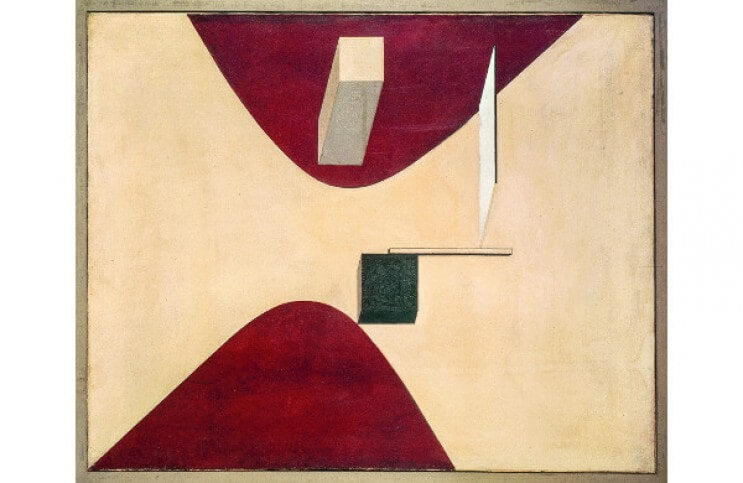
At Centre Pompidou, Artists from the People's Art School Vitebsk
When recounting Modernist art history it is tempting to focus only on Paris, since most 20th Century innovators from everywhere else in the world eventually came to that city. But the story of Modernism, and especially that of Abstraction, cannot fully be told without mentioning the People's Art School, Vitebsk. That story, ironically enough, is currently being told at the Centre Pompidou, in Paris, in the exhibition Chagall, Lissitzky, Malevich: The Russian vanguard at Vitebsk (1918-1922). Featuring more than 250 works and a trove of supporting documents, this exhibition shines a spotlight on the post-revolutionary time in Russia, when a series of rare factors came together that enabled one of the most spectacular art schools of the past century to develop.
The Home of Chagall
Located in modern day Belarus, Vitebsk was once one of the cultural capitals of Russia. It was also the home of the legendary artist Marc Chagall. Born to a working class Jewish family in 1887, Chagall had many things working against him that could easily have prevented him from growing up to be the influential artist he eventually became. He often recounted lying to passersby about being Jewish as a child, because of the implicit threat that they would murder him. His mother even had to bribe a teacher in order to get Chagall admitted into a Russian high school, since Jewish children were not allowed to be enrolled.
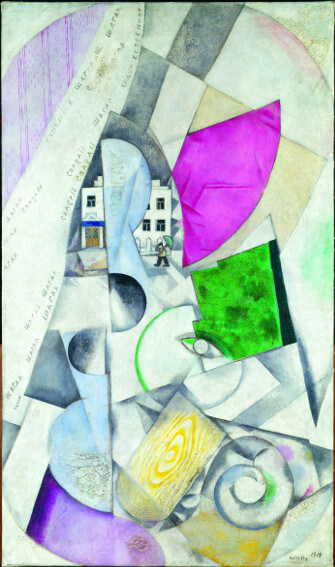
Marc Chagall - Cubist Landscape, 1919, Oil, tempera, graphite, plaster on canvas, 100 × 59 cm, Collection Centre Pompidou, musée national d’art moderne, Photo: Ph. Migeat/Dist. RMN/GP, © Adagp, Paris 2018
Though he conducted all of his early artistic training in Russia, Chagall eventually left the country for Paris in 1910. He had already seen many innovations while studying in St. Petersburg, but it was in Paris that he came alive to the true possibilities of the avant-garde. His own vivid imagination and genius combined with the ideas of the many artists he met there, inspiring him to believe that he could change the world with his art. He took that pioneering spirit with him when he returned to Russia just before the first World War. Life was miserable for most people at the time. But Chagall exhibited his work and made for himself a great reputation. Eventually, his artistic talents led him to be designated as a member of the so-called “aesthetic arm of the revolution.” He received special privileges, not the least of which was an opportunity to open an art school in his home town. The Vitebsk School soon became the most important art school in Russia, and to this day is renowned as the place where the Modernist Russian avant-garde took root.
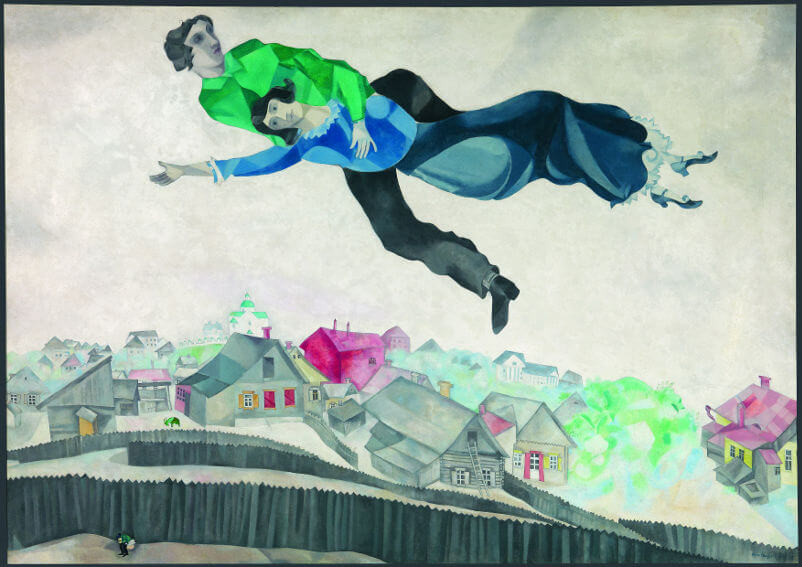
Marc Chagall - Over the City, 1914 – 1918, Oil on canvas, 139 × 197 cm, National Tretyakov Gallery, Moscow, © Adagp, Paris 2018
Early Days in Vitebsk
When Chagall was still a teenager, he took realistic painting classes from Yehuda Pen, a leading member of the Russian Jewish Renaissance of the early 20th Century. Chagall quickly turned away from the realistic style Pen taught, but it was during his time at that school that he met and befriended El Lissitzky, another young painter. A born leader, Lissitzky was already teaching at age 15. He was talented as a realistic artist, but was also extremely prolific and versatile. He fancied himself a designer, an architect, a philosopher, a typographer, a photographer and a painter. Most importantly to Chagall, Lissitzky was open-minded about the global trends emerging at the dawn of the 20th Century, which were leading toward the development of abstract art.
When Chagall moved back to Vitebsk to open up his art school, Lissitzky was one of the first teachers he recruited to join him. Shortly after coming to the school, Lissitzky was then successful in recruiting another influential teacher to the school—Kazimir Malevich. By this time, Malevich was already well known for his innovative new style, called Suprematism. He had published his Suprematist Manifesto in 1915, titled From Cubism to Suprematism. Malevich was a controversial figure, especially to the locals in Vitebsk who preferred figurative art. He was, however, an inspiration to artists like Lissitzky, who embraced the need for progress in art. Malevich and Lissitzky continued teaching at the Vitebsk School for three years, even after Chagall himself left. During this time, they trained a new generation of the avant-garde, and laid the foundations for what would become one of the most innovative periods in Russian art.
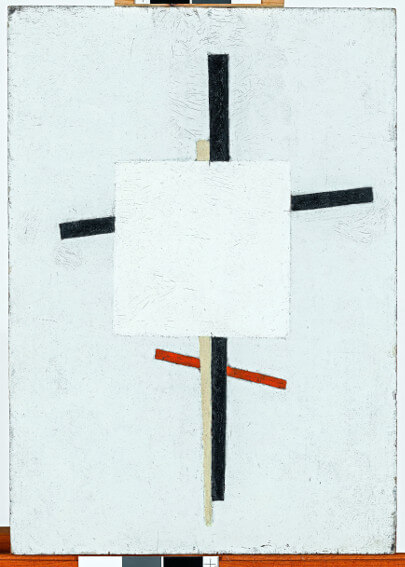
Kazimir Malevich - Suprematism of the mind, 1919, Oil on panel, 55.6 × 38.7 cm, Stedelijk Museum Collection, Amsterdam, On loan from the Cultural Heritage Agency of the Netherlands and Stichting Khardzhiev
The UNOVIS Group
Much of what is on view in Chagall, Lissitzky, Malevich: The Russian vanguard at Vitebsk (1918-1922) relates to the UNOVIS Group, a faction created by Malevich at the Vitebsk School. Originally called POSNOVIS, which stood for “Posledovateli Novovo Iskusstva,” or “Followers of the New Art,” this collective took a multi-disciplined approach to artistic innovation. They branched out far beyond painting and sculpture into the worlds of stage productions, publications, government propaganda, and many other forms of art and media. The UNOVIS Group was a sort of living manifestation of the concept that art should contribute in a material way to the betterment of society. But the group eventually disbanded, due to disagreements between members who favored a more metaphysical approach to making art.
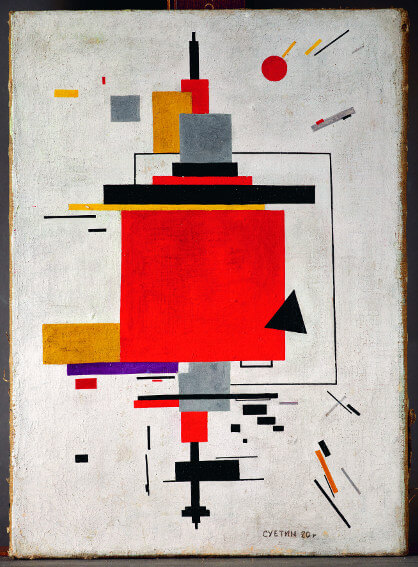
Nikolaï Suyetin - Komposition, 1920, Oil on canvas, 45 × 32.5 cm, Museum Ludwig, Cologne
Though the current Pompidou exhibition primarily focuses on the work of Chagall, Lissitzky and Malevich, it also presents work from a range of other teachers and students who were connected to the Vitebsk School. Works are on view by Vera Ermolaeva, Nicolaï Souietine, Ilia Tchachnik, Lazar Khidekel and David Yakerson. Despite the fact that in the decades following the foundation of this school, Soviet Realism took over as the dominant style of art in Russia, the work these individuals did in the brief time they were active forever defined Russia as a pioneering nation in the field of Modernism and Abstraction. The range of visions represented in the show adds much to our understanding of just how influential this relatively small school eventually became as its members disbanded and spread to the capitals of Europe. Chagall, Lissitzky, Malevich: The Russian vanguard at Vitebsk (1918-1922) is on view at Centre Pompidou through 16 July 2018.
Featured image: El Lissitzky - Proun P23, no. 6, 1919, Tempera on canvas, 62.9 × 77.5 cm, © Van Abbemuseum collection, Eindhoven, Netherlands, Photo: © Peter Cox, Eindhoven, Netherlands
By Phillip Barcio






